Social Work Report: Analyzing Use of Self, Human Rights, and Justice
VerifiedAdded on 2022/08/21
|9
|2602
|14
Report
AI Summary
This report delves into the critical aspects of social work, focusing on the 'use of self' approach, human rights, and the 'ally' model, especially in the context of assisting an 18-year-old with a criminal history and drug addiction. It examines the application of various frameworks, including the ecological and acculturation models, to understand and address the complexities of addiction and recovery. The report emphasizes the importance of social justice, planned change theory, and the impact of power dynamics in therapeutic settings. Furthermore, it highlights the significance of rituals and social context in supporting recovery, as well as the need for social workers to critically evaluate their biases and promote inclusivity, ultimately aiming to facilitate positive life changes for individuals like Janet, the case study's subject. The report draws upon multiple scholarly references to support its analysis and recommendations, underscoring the importance of a comprehensive and empathetic approach in social work practice.
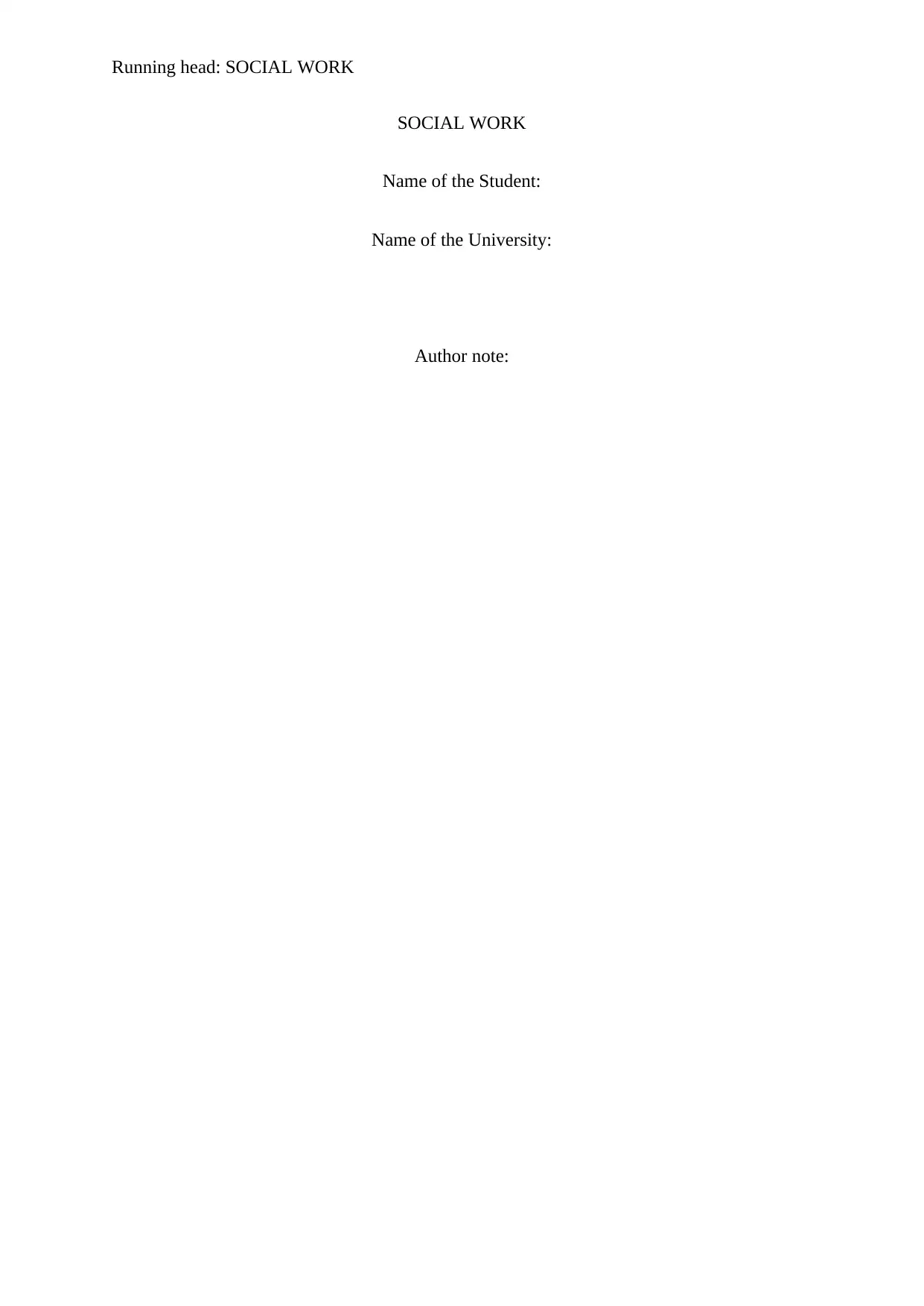
Running head: SOCIAL WORK
SOCIAL WORK
Name of the Student:
Name of the University:
Author note:
SOCIAL WORK
Name of the Student:
Name of the University:
Author note:
Paraphrase This Document
Need a fresh take? Get an instant paraphrase of this document with our AI Paraphraser
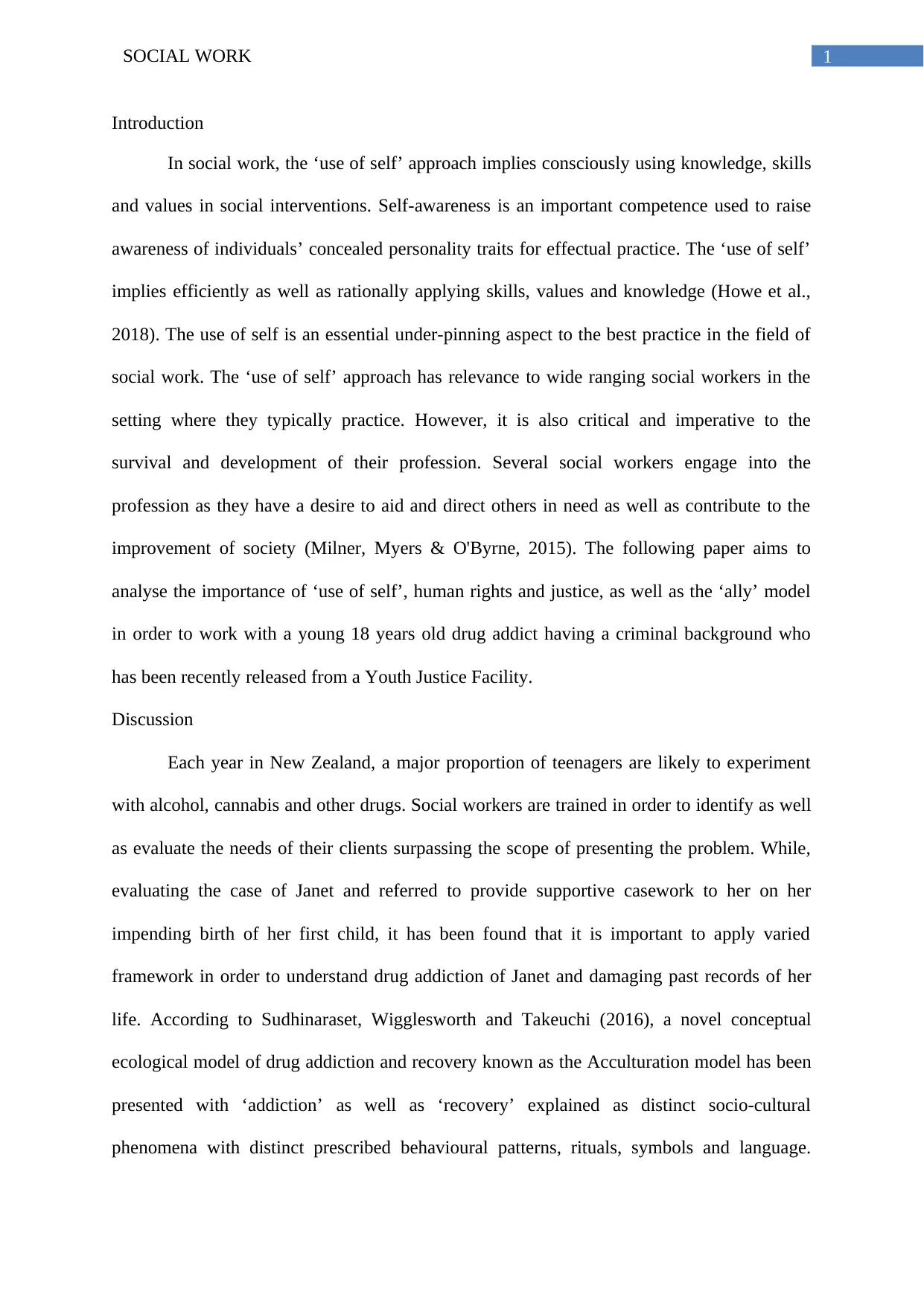
1SOCIAL WORK
Introduction
In social work, the ‘use of self’ approach implies consciously using knowledge, skills
and values in social interventions. Self-awareness is an important competence used to raise
awareness of individuals’ concealed personality traits for effectual practice. The ‘use of self’
implies efficiently as well as rationally applying skills, values and knowledge (Howe et al.,
2018). The use of self is an essential under-pinning aspect to the best practice in the field of
social work. The ‘use of self’ approach has relevance to wide ranging social workers in the
setting where they typically practice. However, it is also critical and imperative to the
survival and development of their profession. Several social workers engage into the
profession as they have a desire to aid and direct others in need as well as contribute to the
improvement of society (Milner, Myers & O'Byrne, 2015). The following paper aims to
analyse the importance of ‘use of self’, human rights and justice, as well as the ‘ally’ model
in order to work with a young 18 years old drug addict having a criminal background who
has been recently released from a Youth Justice Facility.
Discussion
Each year in New Zealand, a major proportion of teenagers are likely to experiment
with alcohol, cannabis and other drugs. Social workers are trained in order to identify as well
as evaluate the needs of their clients surpassing the scope of presenting the problem. While,
evaluating the case of Janet and referred to provide supportive casework to her on her
impending birth of her first child, it has been found that it is important to apply varied
framework in order to understand drug addiction of Janet and damaging past records of her
life. According to Sudhinaraset, Wigglesworth and Takeuchi (2016), a novel conceptual
ecological model of drug addiction and recovery known as the Acculturation model has been
presented with ‘addiction’ as well as ‘recovery’ explained as distinct socio-cultural
phenomena with distinct prescribed behavioural patterns, rituals, symbols and language.
Introduction
In social work, the ‘use of self’ approach implies consciously using knowledge, skills
and values in social interventions. Self-awareness is an important competence used to raise
awareness of individuals’ concealed personality traits for effectual practice. The ‘use of self’
implies efficiently as well as rationally applying skills, values and knowledge (Howe et al.,
2018). The use of self is an essential under-pinning aspect to the best practice in the field of
social work. The ‘use of self’ approach has relevance to wide ranging social workers in the
setting where they typically practice. However, it is also critical and imperative to the
survival and development of their profession. Several social workers engage into the
profession as they have a desire to aid and direct others in need as well as contribute to the
improvement of society (Milner, Myers & O'Byrne, 2015). The following paper aims to
analyse the importance of ‘use of self’, human rights and justice, as well as the ‘ally’ model
in order to work with a young 18 years old drug addict having a criminal background who
has been recently released from a Youth Justice Facility.
Discussion
Each year in New Zealand, a major proportion of teenagers are likely to experiment
with alcohol, cannabis and other drugs. Social workers are trained in order to identify as well
as evaluate the needs of their clients surpassing the scope of presenting the problem. While,
evaluating the case of Janet and referred to provide supportive casework to her on her
impending birth of her first child, it has been found that it is important to apply varied
framework in order to understand drug addiction of Janet and damaging past records of her
life. According to Sudhinaraset, Wigglesworth and Takeuchi (2016), a novel conceptual
ecological model of drug addiction and recovery known as the Acculturation model has been
presented with ‘addiction’ as well as ‘recovery’ explained as distinct socio-cultural
phenomena with distinct prescribed behavioural patterns, rituals, symbols and language.
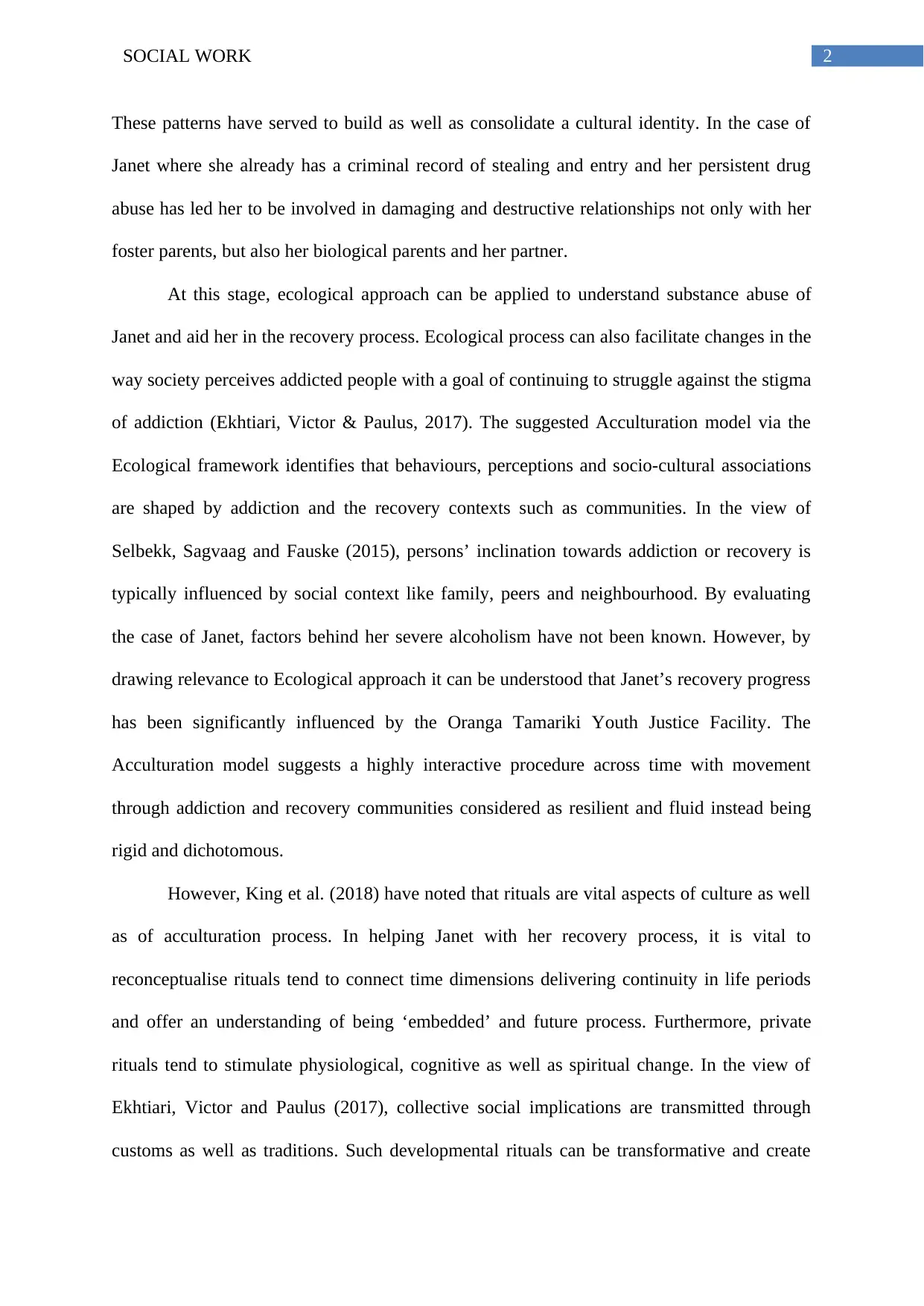
2SOCIAL WORK
These patterns have served to build as well as consolidate a cultural identity. In the case of
Janet where she already has a criminal record of stealing and entry and her persistent drug
abuse has led her to be involved in damaging and destructive relationships not only with her
foster parents, but also her biological parents and her partner.
At this stage, ecological approach can be applied to understand substance abuse of
Janet and aid her in the recovery process. Ecological process can also facilitate changes in the
way society perceives addicted people with a goal of continuing to struggle against the stigma
of addiction (Ekhtiari, Victor & Paulus, 2017). The suggested Acculturation model via the
Ecological framework identifies that behaviours, perceptions and socio-cultural associations
are shaped by addiction and the recovery contexts such as communities. In the view of
Selbekk, Sagvaag and Fauske (2015), persons’ inclination towards addiction or recovery is
typically influenced by social context like family, peers and neighbourhood. By evaluating
the case of Janet, factors behind her severe alcoholism have not been known. However, by
drawing relevance to Ecological approach it can be understood that Janet’s recovery progress
has been significantly influenced by the Oranga Tamariki Youth Justice Facility. The
Acculturation model suggests a highly interactive procedure across time with movement
through addiction and recovery communities considered as resilient and fluid instead being
rigid and dichotomous.
However, King et al. (2018) have noted that rituals are vital aspects of culture as well
as of acculturation process. In helping Janet with her recovery process, it is vital to
reconceptualise rituals tend to connect time dimensions delivering continuity in life periods
and offer an understanding of being ‘embedded’ and future process. Furthermore, private
rituals tend to stimulate physiological, cognitive as well as spiritual change. In the view of
Ekhtiari, Victor and Paulus (2017), collective social implications are transmitted through
customs as well as traditions. Such developmental rituals can be transformative and create
These patterns have served to build as well as consolidate a cultural identity. In the case of
Janet where she already has a criminal record of stealing and entry and her persistent drug
abuse has led her to be involved in damaging and destructive relationships not only with her
foster parents, but also her biological parents and her partner.
At this stage, ecological approach can be applied to understand substance abuse of
Janet and aid her in the recovery process. Ecological process can also facilitate changes in the
way society perceives addicted people with a goal of continuing to struggle against the stigma
of addiction (Ekhtiari, Victor & Paulus, 2017). The suggested Acculturation model via the
Ecological framework identifies that behaviours, perceptions and socio-cultural associations
are shaped by addiction and the recovery contexts such as communities. In the view of
Selbekk, Sagvaag and Fauske (2015), persons’ inclination towards addiction or recovery is
typically influenced by social context like family, peers and neighbourhood. By evaluating
the case of Janet, factors behind her severe alcoholism have not been known. However, by
drawing relevance to Ecological approach it can be understood that Janet’s recovery progress
has been significantly influenced by the Oranga Tamariki Youth Justice Facility. The
Acculturation model suggests a highly interactive procedure across time with movement
through addiction and recovery communities considered as resilient and fluid instead being
rigid and dichotomous.
However, King et al. (2018) have noted that rituals are vital aspects of culture as well
as of acculturation process. In helping Janet with her recovery process, it is vital to
reconceptualise rituals tend to connect time dimensions delivering continuity in life periods
and offer an understanding of being ‘embedded’ and future process. Furthermore, private
rituals tend to stimulate physiological, cognitive as well as spiritual change. In the view of
Ekhtiari, Victor and Paulus (2017), collective social implications are transmitted through
customs as well as traditions. Such developmental rituals can be transformative and create
⊘ This is a preview!⊘
Do you want full access?
Subscribe today to unlock all pages.

Trusted by 1+ million students worldwide
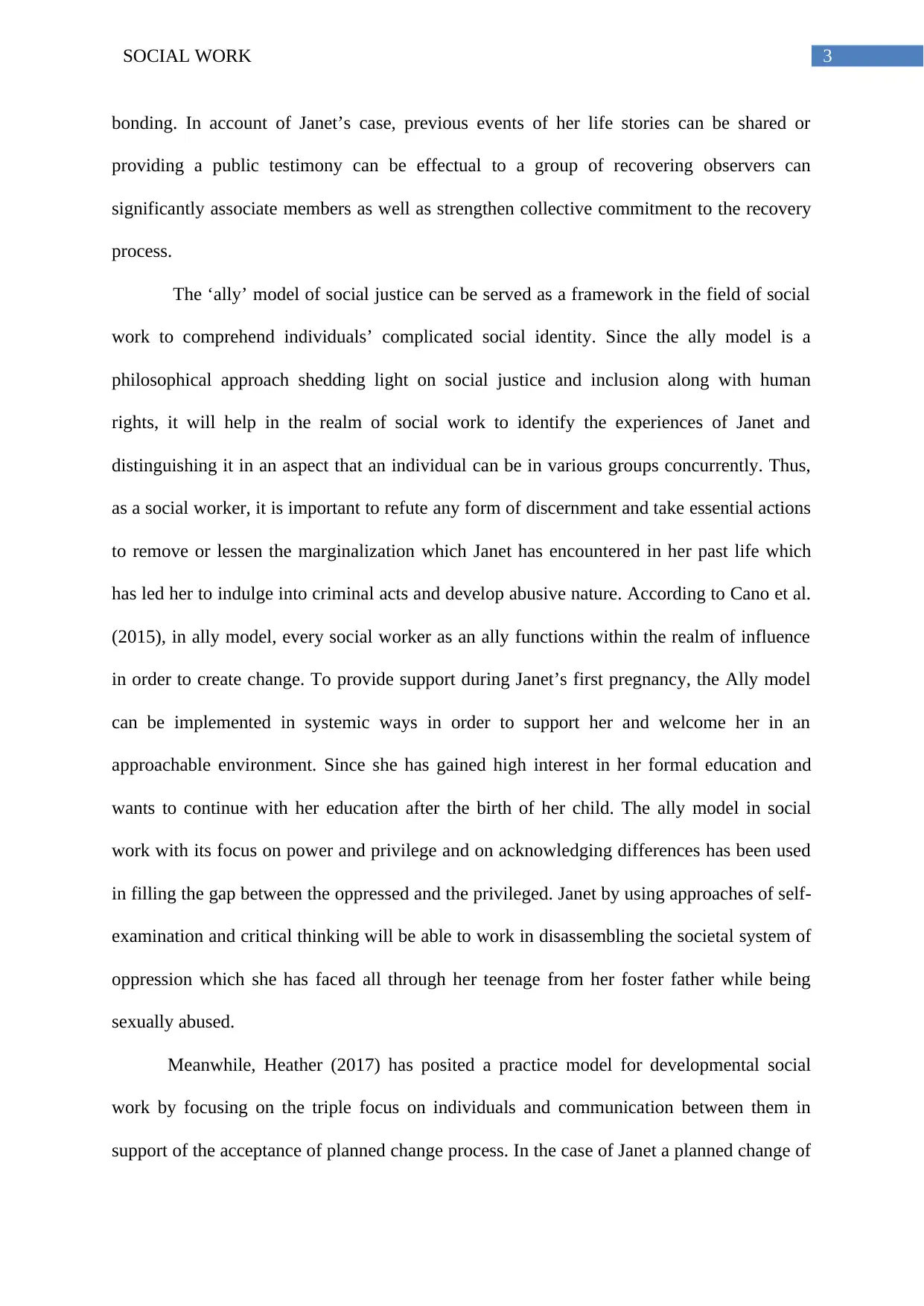
3SOCIAL WORK
bonding. In account of Janet’s case, previous events of her life stories can be shared or
providing a public testimony can be effectual to a group of recovering observers can
significantly associate members as well as strengthen collective commitment to the recovery
process.
The ‘ally’ model of social justice can be served as a framework in the field of social
work to comprehend individuals’ complicated social identity. Since the ally model is a
philosophical approach shedding light on social justice and inclusion along with human
rights, it will help in the realm of social work to identify the experiences of Janet and
distinguishing it in an aspect that an individual can be in various groups concurrently. Thus,
as a social worker, it is important to refute any form of discernment and take essential actions
to remove or lessen the marginalization which Janet has encountered in her past life which
has led her to indulge into criminal acts and develop abusive nature. According to Cano et al.
(2015), in ally model, every social worker as an ally functions within the realm of influence
in order to create change. To provide support during Janet’s first pregnancy, the Ally model
can be implemented in systemic ways in order to support her and welcome her in an
approachable environment. Since she has gained high interest in her formal education and
wants to continue with her education after the birth of her child. The ally model in social
work with its focus on power and privilege and on acknowledging differences has been used
in filling the gap between the oppressed and the privileged. Janet by using approaches of self-
examination and critical thinking will be able to work in disassembling the societal system of
oppression which she has faced all through her teenage from her foster father while being
sexually abused.
Meanwhile, Heather (2017) has posited a practice model for developmental social
work by focusing on the triple focus on individuals and communication between them in
support of the acceptance of planned change process. In the case of Janet a planned change of
bonding. In account of Janet’s case, previous events of her life stories can be shared or
providing a public testimony can be effectual to a group of recovering observers can
significantly associate members as well as strengthen collective commitment to the recovery
process.
The ‘ally’ model of social justice can be served as a framework in the field of social
work to comprehend individuals’ complicated social identity. Since the ally model is a
philosophical approach shedding light on social justice and inclusion along with human
rights, it will help in the realm of social work to identify the experiences of Janet and
distinguishing it in an aspect that an individual can be in various groups concurrently. Thus,
as a social worker, it is important to refute any form of discernment and take essential actions
to remove or lessen the marginalization which Janet has encountered in her past life which
has led her to indulge into criminal acts and develop abusive nature. According to Cano et al.
(2015), in ally model, every social worker as an ally functions within the realm of influence
in order to create change. To provide support during Janet’s first pregnancy, the Ally model
can be implemented in systemic ways in order to support her and welcome her in an
approachable environment. Since she has gained high interest in her formal education and
wants to continue with her education after the birth of her child. The ally model in social
work with its focus on power and privilege and on acknowledging differences has been used
in filling the gap between the oppressed and the privileged. Janet by using approaches of self-
examination and critical thinking will be able to work in disassembling the societal system of
oppression which she has faced all through her teenage from her foster father while being
sexually abused.
Meanwhile, Heather (2017) has posited a practice model for developmental social
work by focusing on the triple focus on individuals and communication between them in
support of the acceptance of planned change process. In the case of Janet a planned change of
Paraphrase This Document
Need a fresh take? Get an instant paraphrase of this document with our AI Paraphraser
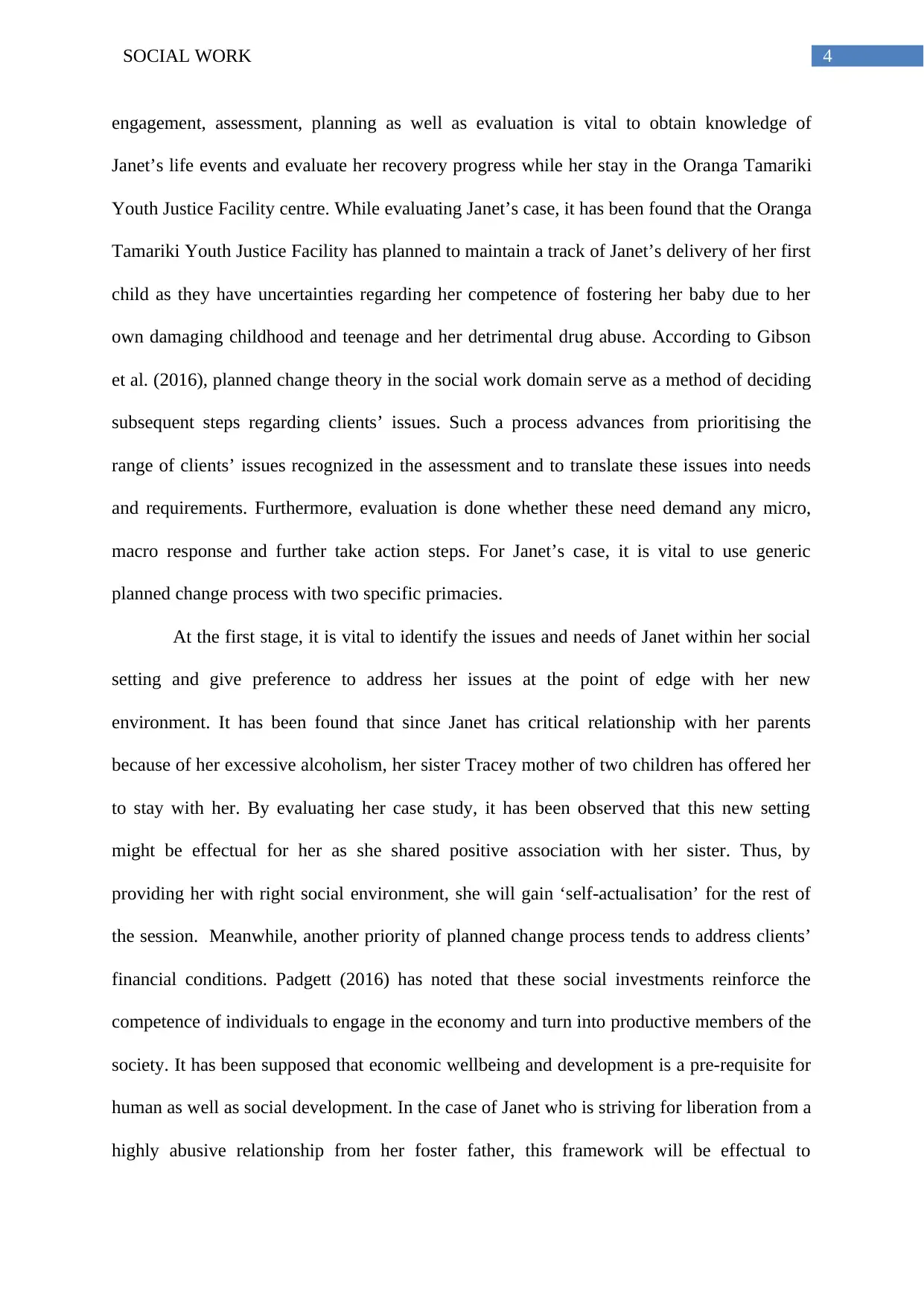
4SOCIAL WORK
engagement, assessment, planning as well as evaluation is vital to obtain knowledge of
Janet’s life events and evaluate her recovery progress while her stay in the Oranga Tamariki
Youth Justice Facility centre. While evaluating Janet’s case, it has been found that the Oranga
Tamariki Youth Justice Facility has planned to maintain a track of Janet’s delivery of her first
child as they have uncertainties regarding her competence of fostering her baby due to her
own damaging childhood and teenage and her detrimental drug abuse. According to Gibson
et al. (2016), planned change theory in the social work domain serve as a method of deciding
subsequent steps regarding clients’ issues. Such a process advances from prioritising the
range of clients’ issues recognized in the assessment and to translate these issues into needs
and requirements. Furthermore, evaluation is done whether these need demand any micro,
macro response and further take action steps. For Janet’s case, it is vital to use generic
planned change process with two specific primacies.
At the first stage, it is vital to identify the issues and needs of Janet within her social
setting and give preference to address her issues at the point of edge with her new
environment. It has been found that since Janet has critical relationship with her parents
because of her excessive alcoholism, her sister Tracey mother of two children has offered her
to stay with her. By evaluating her case study, it has been observed that this new setting
might be effectual for her as she shared positive association with her sister. Thus, by
providing her with right social environment, she will gain ‘self-actualisation’ for the rest of
the session. Meanwhile, another priority of planned change process tends to address clients’
financial conditions. Padgett (2016) has noted that these social investments reinforce the
competence of individuals to engage in the economy and turn into productive members of the
society. It has been supposed that economic wellbeing and development is a pre-requisite for
human as well as social development. In the case of Janet who is striving for liberation from a
highly abusive relationship from her foster father, this framework will be effectual to
engagement, assessment, planning as well as evaluation is vital to obtain knowledge of
Janet’s life events and evaluate her recovery progress while her stay in the Oranga Tamariki
Youth Justice Facility centre. While evaluating Janet’s case, it has been found that the Oranga
Tamariki Youth Justice Facility has planned to maintain a track of Janet’s delivery of her first
child as they have uncertainties regarding her competence of fostering her baby due to her
own damaging childhood and teenage and her detrimental drug abuse. According to Gibson
et al. (2016), planned change theory in the social work domain serve as a method of deciding
subsequent steps regarding clients’ issues. Such a process advances from prioritising the
range of clients’ issues recognized in the assessment and to translate these issues into needs
and requirements. Furthermore, evaluation is done whether these need demand any micro,
macro response and further take action steps. For Janet’s case, it is vital to use generic
planned change process with two specific primacies.
At the first stage, it is vital to identify the issues and needs of Janet within her social
setting and give preference to address her issues at the point of edge with her new
environment. It has been found that since Janet has critical relationship with her parents
because of her excessive alcoholism, her sister Tracey mother of two children has offered her
to stay with her. By evaluating her case study, it has been observed that this new setting
might be effectual for her as she shared positive association with her sister. Thus, by
providing her with right social environment, she will gain ‘self-actualisation’ for the rest of
the session. Meanwhile, another priority of planned change process tends to address clients’
financial conditions. Padgett (2016) has noted that these social investments reinforce the
competence of individuals to engage in the economy and turn into productive members of the
society. It has been supposed that economic wellbeing and development is a pre-requisite for
human as well as social development. In the case of Janet who is striving for liberation from a
highly abusive relationship from her foster father, this framework will be effectual to
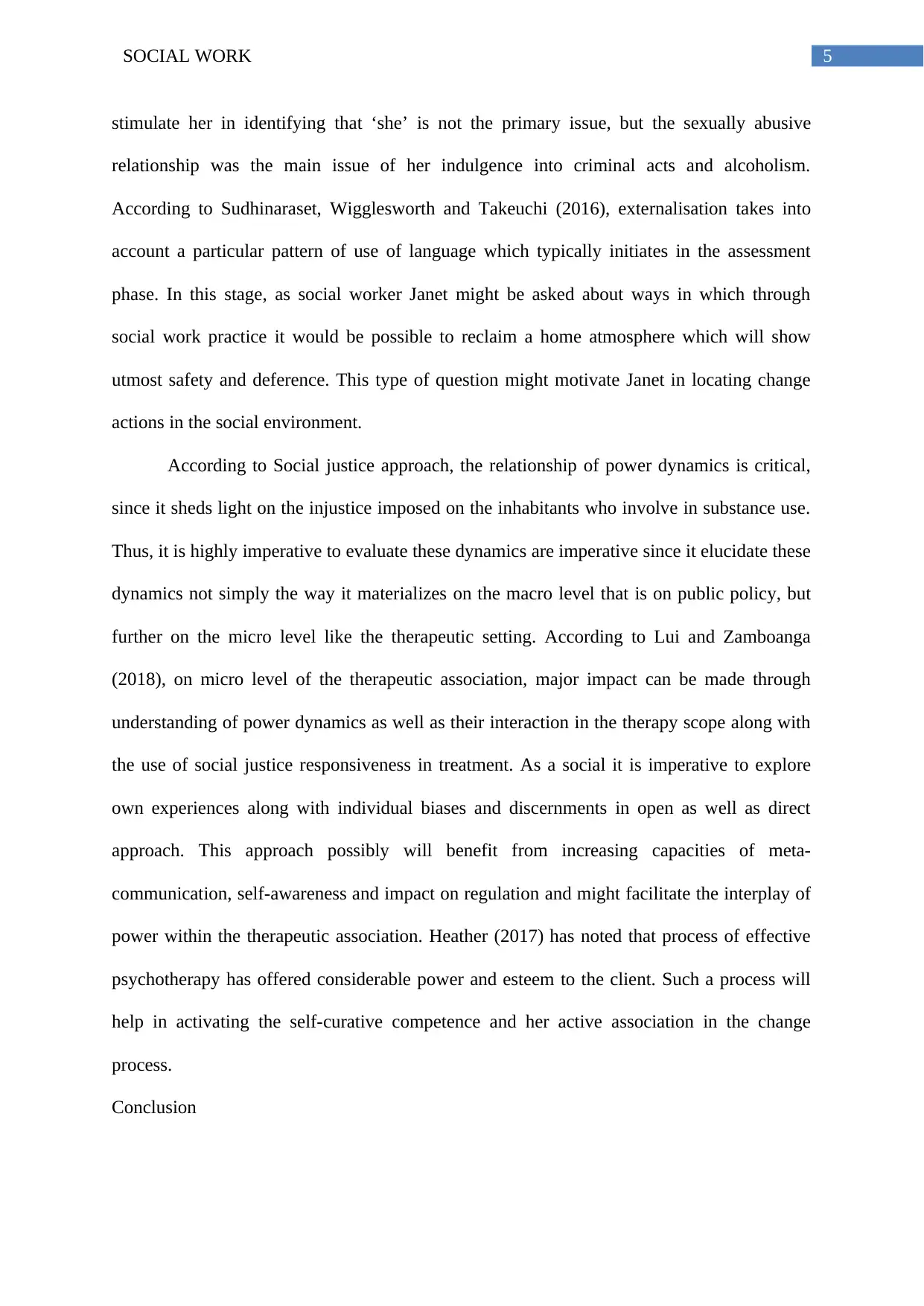
5SOCIAL WORK
stimulate her in identifying that ‘she’ is not the primary issue, but the sexually abusive
relationship was the main issue of her indulgence into criminal acts and alcoholism.
According to Sudhinaraset, Wigglesworth and Takeuchi (2016), externalisation takes into
account a particular pattern of use of language which typically initiates in the assessment
phase. In this stage, as social worker Janet might be asked about ways in which through
social work practice it would be possible to reclaim a home atmosphere which will show
utmost safety and deference. This type of question might motivate Janet in locating change
actions in the social environment.
According to Social justice approach, the relationship of power dynamics is critical,
since it sheds light on the injustice imposed on the inhabitants who involve in substance use.
Thus, it is highly imperative to evaluate these dynamics are imperative since it elucidate these
dynamics not simply the way it materializes on the macro level that is on public policy, but
further on the micro level like the therapeutic setting. According to Lui and Zamboanga
(2018), on micro level of the therapeutic association, major impact can be made through
understanding of power dynamics as well as their interaction in the therapy scope along with
the use of social justice responsiveness in treatment. As a social it is imperative to explore
own experiences along with individual biases and discernments in open as well as direct
approach. This approach possibly will benefit from increasing capacities of meta-
communication, self-awareness and impact on regulation and might facilitate the interplay of
power within the therapeutic association. Heather (2017) has noted that process of effective
psychotherapy has offered considerable power and esteem to the client. Such a process will
help in activating the self-curative competence and her active association in the change
process.
Conclusion
stimulate her in identifying that ‘she’ is not the primary issue, but the sexually abusive
relationship was the main issue of her indulgence into criminal acts and alcoholism.
According to Sudhinaraset, Wigglesworth and Takeuchi (2016), externalisation takes into
account a particular pattern of use of language which typically initiates in the assessment
phase. In this stage, as social worker Janet might be asked about ways in which through
social work practice it would be possible to reclaim a home atmosphere which will show
utmost safety and deference. This type of question might motivate Janet in locating change
actions in the social environment.
According to Social justice approach, the relationship of power dynamics is critical,
since it sheds light on the injustice imposed on the inhabitants who involve in substance use.
Thus, it is highly imperative to evaluate these dynamics are imperative since it elucidate these
dynamics not simply the way it materializes on the macro level that is on public policy, but
further on the micro level like the therapeutic setting. According to Lui and Zamboanga
(2018), on micro level of the therapeutic association, major impact can be made through
understanding of power dynamics as well as their interaction in the therapy scope along with
the use of social justice responsiveness in treatment. As a social it is imperative to explore
own experiences along with individual biases and discernments in open as well as direct
approach. This approach possibly will benefit from increasing capacities of meta-
communication, self-awareness and impact on regulation and might facilitate the interplay of
power within the therapeutic association. Heather (2017) has noted that process of effective
psychotherapy has offered considerable power and esteem to the client. Such a process will
help in activating the self-curative competence and her active association in the change
process.
Conclusion
⊘ This is a preview!⊘
Do you want full access?
Subscribe today to unlock all pages.

Trusted by 1+ million students worldwide
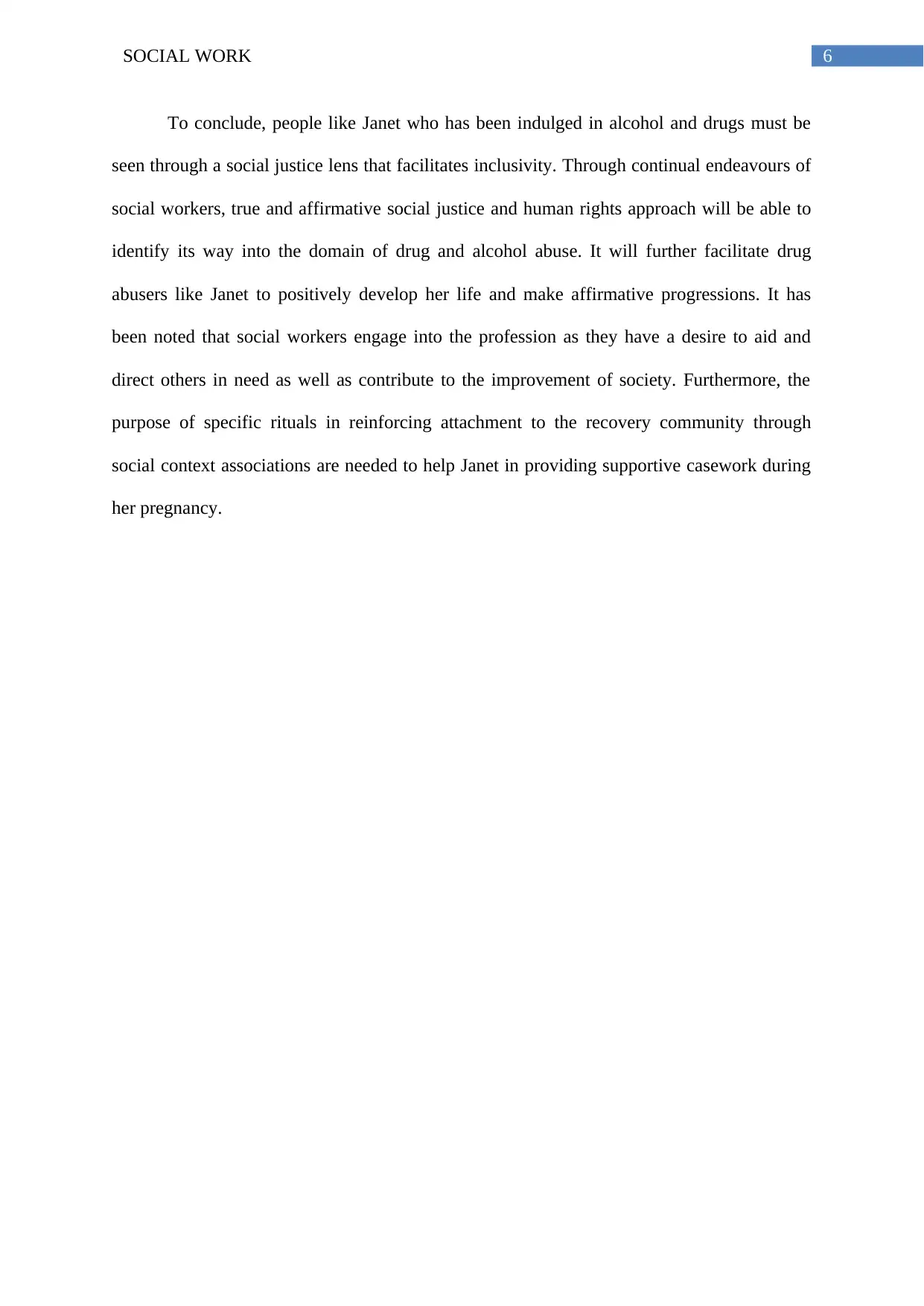
6SOCIAL WORK
To conclude, people like Janet who has been indulged in alcohol and drugs must be
seen through a social justice lens that facilitates inclusivity. Through continual endeavours of
social workers, true and affirmative social justice and human rights approach will be able to
identify its way into the domain of drug and alcohol abuse. It will further facilitate drug
abusers like Janet to positively develop her life and make affirmative progressions. It has
been noted that social workers engage into the profession as they have a desire to aid and
direct others in need as well as contribute to the improvement of society. Furthermore, the
purpose of specific rituals in reinforcing attachment to the recovery community through
social context associations are needed to help Janet in providing supportive casework during
her pregnancy.
To conclude, people like Janet who has been indulged in alcohol and drugs must be
seen through a social justice lens that facilitates inclusivity. Through continual endeavours of
social workers, true and affirmative social justice and human rights approach will be able to
identify its way into the domain of drug and alcohol abuse. It will further facilitate drug
abusers like Janet to positively develop her life and make affirmative progressions. It has
been noted that social workers engage into the profession as they have a desire to aid and
direct others in need as well as contribute to the improvement of society. Furthermore, the
purpose of specific rituals in reinforcing attachment to the recovery community through
social context associations are needed to help Janet in providing supportive casework during
her pregnancy.
Paraphrase This Document
Need a fresh take? Get an instant paraphrase of this document with our AI Paraphraser
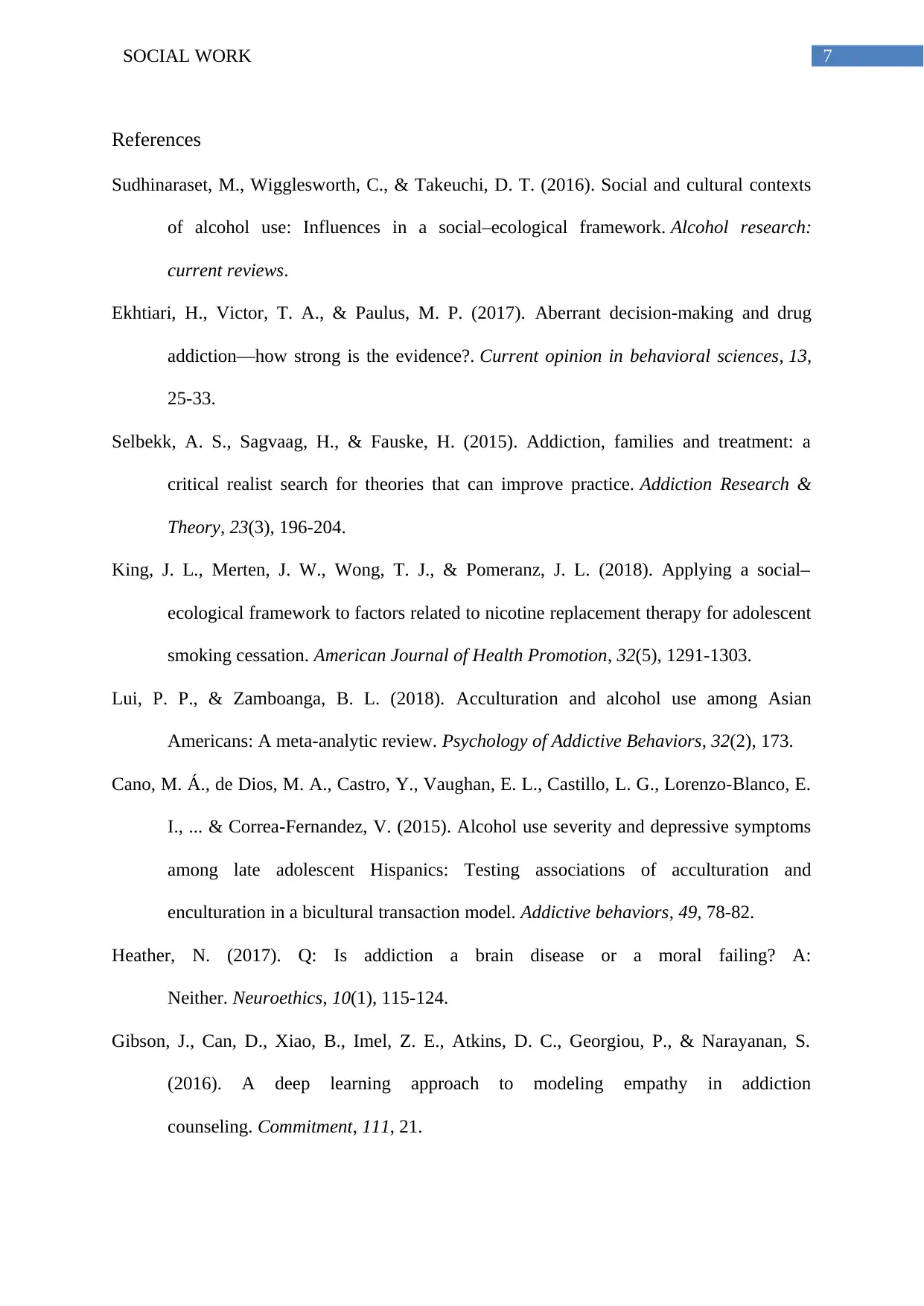
7SOCIAL WORK
References
Sudhinaraset, M., Wigglesworth, C., & Takeuchi, D. T. (2016). Social and cultural contexts
of alcohol use: Influences in a social–ecological framework. Alcohol research:
current reviews.
Ekhtiari, H., Victor, T. A., & Paulus, M. P. (2017). Aberrant decision-making and drug
addiction—how strong is the evidence?. Current opinion in behavioral sciences, 13,
25-33.
Selbekk, A. S., Sagvaag, H., & Fauske, H. (2015). Addiction, families and treatment: a
critical realist search for theories that can improve practice. Addiction Research &
Theory, 23(3), 196-204.
King, J. L., Merten, J. W., Wong, T. J., & Pomeranz, J. L. (2018). Applying a social–
ecological framework to factors related to nicotine replacement therapy for adolescent
smoking cessation. American Journal of Health Promotion, 32(5), 1291-1303.
Lui, P. P., & Zamboanga, B. L. (2018). Acculturation and alcohol use among Asian
Americans: A meta-analytic review. Psychology of Addictive Behaviors, 32(2), 173.
Cano, M. Á., de Dios, M. A., Castro, Y., Vaughan, E. L., Castillo, L. G., Lorenzo-Blanco, E.
I., ... & Correa-Fernandez, V. (2015). Alcohol use severity and depressive symptoms
among late adolescent Hispanics: Testing associations of acculturation and
enculturation in a bicultural transaction model. Addictive behaviors, 49, 78-82.
Heather, N. (2017). Q: Is addiction a brain disease or a moral failing? A:
Neither. Neuroethics, 10(1), 115-124.
Gibson, J., Can, D., Xiao, B., Imel, Z. E., Atkins, D. C., Georgiou, P., & Narayanan, S.
(2016). A deep learning approach to modeling empathy in addiction
counseling. Commitment, 111, 21.
References
Sudhinaraset, M., Wigglesworth, C., & Takeuchi, D. T. (2016). Social and cultural contexts
of alcohol use: Influences in a social–ecological framework. Alcohol research:
current reviews.
Ekhtiari, H., Victor, T. A., & Paulus, M. P. (2017). Aberrant decision-making and drug
addiction—how strong is the evidence?. Current opinion in behavioral sciences, 13,
25-33.
Selbekk, A. S., Sagvaag, H., & Fauske, H. (2015). Addiction, families and treatment: a
critical realist search for theories that can improve practice. Addiction Research &
Theory, 23(3), 196-204.
King, J. L., Merten, J. W., Wong, T. J., & Pomeranz, J. L. (2018). Applying a social–
ecological framework to factors related to nicotine replacement therapy for adolescent
smoking cessation. American Journal of Health Promotion, 32(5), 1291-1303.
Lui, P. P., & Zamboanga, B. L. (2018). Acculturation and alcohol use among Asian
Americans: A meta-analytic review. Psychology of Addictive Behaviors, 32(2), 173.
Cano, M. Á., de Dios, M. A., Castro, Y., Vaughan, E. L., Castillo, L. G., Lorenzo-Blanco, E.
I., ... & Correa-Fernandez, V. (2015). Alcohol use severity and depressive symptoms
among late adolescent Hispanics: Testing associations of acculturation and
enculturation in a bicultural transaction model. Addictive behaviors, 49, 78-82.
Heather, N. (2017). Q: Is addiction a brain disease or a moral failing? A:
Neither. Neuroethics, 10(1), 115-124.
Gibson, J., Can, D., Xiao, B., Imel, Z. E., Atkins, D. C., Georgiou, P., & Narayanan, S.
(2016). A deep learning approach to modeling empathy in addiction
counseling. Commitment, 111, 21.
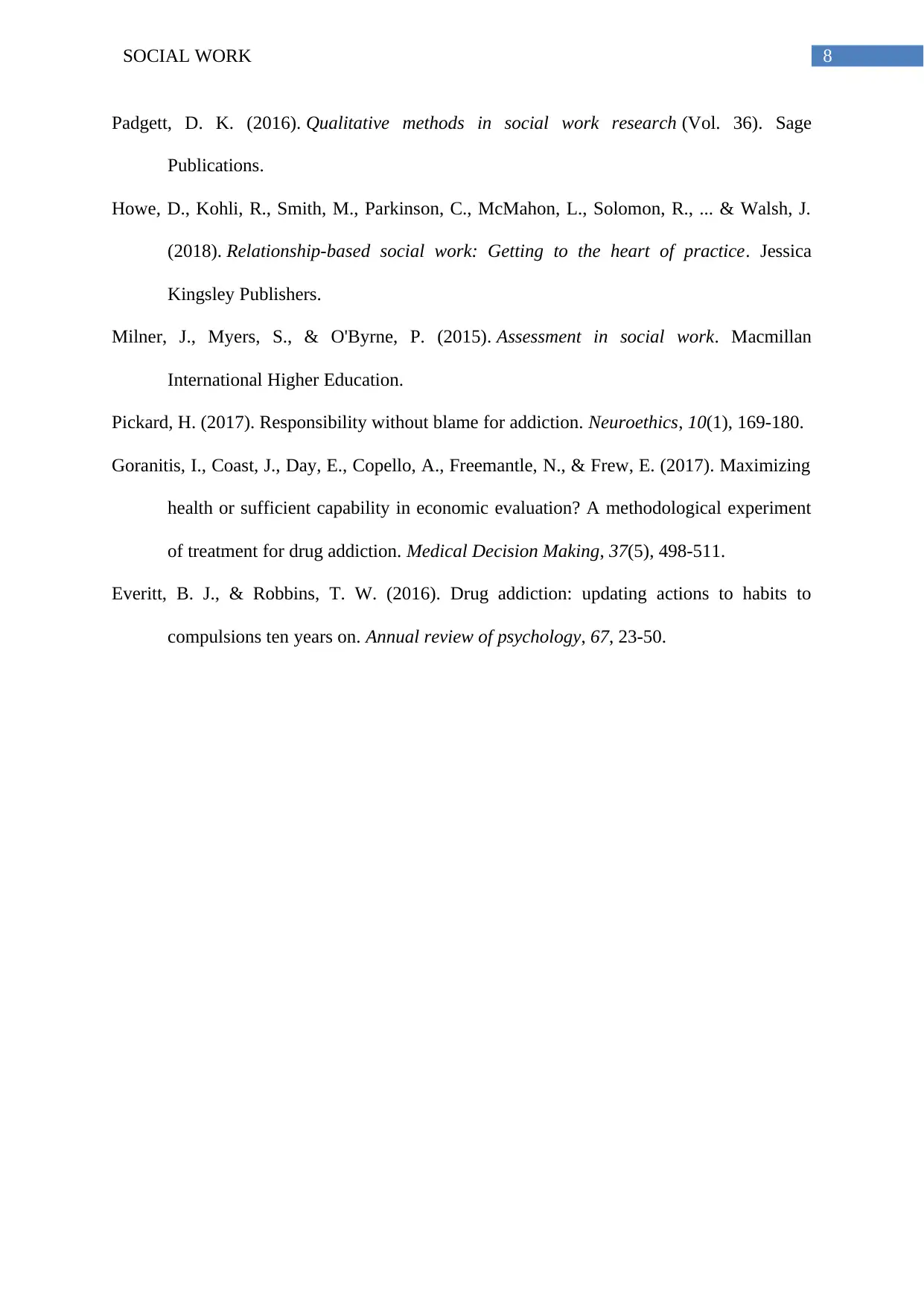
8SOCIAL WORK
Padgett, D. K. (2016). Qualitative methods in social work research (Vol. 36). Sage
Publications.
Howe, D., Kohli, R., Smith, M., Parkinson, C., McMahon, L., Solomon, R., ... & Walsh, J.
(2018). Relationship-based social work: Getting to the heart of practice. Jessica
Kingsley Publishers.
Milner, J., Myers, S., & O'Byrne, P. (2015). Assessment in social work. Macmillan
International Higher Education.
Pickard, H. (2017). Responsibility without blame for addiction. Neuroethics, 10(1), 169-180.
Goranitis, I., Coast, J., Day, E., Copello, A., Freemantle, N., & Frew, E. (2017). Maximizing
health or sufficient capability in economic evaluation? A methodological experiment
of treatment for drug addiction. Medical Decision Making, 37(5), 498-511.
Everitt, B. J., & Robbins, T. W. (2016). Drug addiction: updating actions to habits to
compulsions ten years on. Annual review of psychology, 67, 23-50.
Padgett, D. K. (2016). Qualitative methods in social work research (Vol. 36). Sage
Publications.
Howe, D., Kohli, R., Smith, M., Parkinson, C., McMahon, L., Solomon, R., ... & Walsh, J.
(2018). Relationship-based social work: Getting to the heart of practice. Jessica
Kingsley Publishers.
Milner, J., Myers, S., & O'Byrne, P. (2015). Assessment in social work. Macmillan
International Higher Education.
Pickard, H. (2017). Responsibility without blame for addiction. Neuroethics, 10(1), 169-180.
Goranitis, I., Coast, J., Day, E., Copello, A., Freemantle, N., & Frew, E. (2017). Maximizing
health or sufficient capability in economic evaluation? A methodological experiment
of treatment for drug addiction. Medical Decision Making, 37(5), 498-511.
Everitt, B. J., & Robbins, T. W. (2016). Drug addiction: updating actions to habits to
compulsions ten years on. Annual review of psychology, 67, 23-50.
⊘ This is a preview!⊘
Do you want full access?
Subscribe today to unlock all pages.

Trusted by 1+ million students worldwide
1 out of 9
Your All-in-One AI-Powered Toolkit for Academic Success.
+13062052269
info@desklib.com
Available 24*7 on WhatsApp / Email
![[object Object]](/_next/static/media/star-bottom.7253800d.svg)
Unlock your academic potential
Copyright © 2020–2025 A2Z Services. All Rights Reserved. Developed and managed by ZUCOL.

